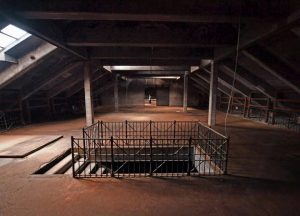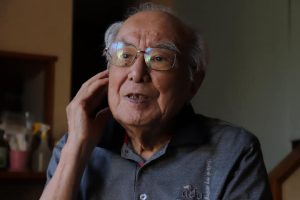Memories engraved in A-bombed buildings, Part 1: Student mobilization
Jul. 21, 2024
Life during mobilization was truly militaristic
by Minami Yamashita, Staff Writer
Takenori Mori, 94, a resident of Kumamoto City, was born and raised in Hiroshima. He was mobilized for work at the former Army Clothing Depot, located in the city’s Minami Ward, with other classmates and spent one year and two months there. “I had the strong impression that the mobilization was a lot like life in the military. In hindsight, it was crazy,” said Mr. Mori. He was forced to support the country’s war efforts in the midst of his youth, and on August 6, 1945, he experienced Hiroshima’s atomic bombing there.
The middle school affiliated with the Hiroshima Higher Normal School (present-day junior high school affiliated with Hiroshima University) that he was attending had a liberal mindset. The school allowed the students to listen to American music, and he received the high score on a history test in which he wrote, “The early emperors are not historical fact but myth.” However, his life changed completely in June 1944, when he was mobilized to serve at the depot. He was assigned to a transport unit mainly helping with the moving of goods and supplies for the Japanese military from the depot to a facility in the Chugoku Mountains.
Students defied orders by going on strike
With only a few days off a month, the students had little time to study. Body searches were carried out every day, and two students who had attempted to remove from the depot products stored there were punished and transferred to another school. “Whatever the military said was a priority. We wanted to resist that structure, which was the complete opposite of the freedom we knew in our school life.” With growing dissatisfaction, the students went on “strike” in the spring of 1945, locking themselves in a locker room and refusing to work. As a representative of the group, Mr. Mori met with an officer, which resulted in a halt to the body searches.
On the morning of August 6, 1945, Mr. Mori, a fourth-year student at the time, was on the cargo bed of a truck with other students waiting for the truck to depart as they usually did when the atomic bomb exploded. “Without realizing what had happened,” he said he hastily lied face down on the ground and then fled to an air-raid shelter. With burns on his face and both hands, he cautiously stepped outside and went to an infirmary where there were already many wounded, making it impossible for him to get treatment.
Empty warehouses were filled with severely wounded victims. Mr. Mori spoke to a student at Hiroshima First Middle School (present-day Hiroshima Kokutaiji Senior High School) he had located in the crowd and asked about the whereabouts of his father, who was a teacher at the school. But the student did not respond. Some warehouses were piled high with corpses. Turning his back to them, his body became heavy with the feeling that “the eyes of the dead were looking at me.” He spent the night in a nearby vacant lot. The roar of the fires after the bombing still rings in his ears to this day.
After finishing middle school, he went to Kumamoto, his father’s hometown, and graduated from the Fifth Higher School (present-day Kumamoto University). He worked for a law firm and became a licensed judicial scrivener. He fought as hard as he could in an administrative lawsuit against the construction of a dam, based on the rebellious spirit fostered in him during the time he was a mobilized student.
Scaling back of reunions
For many years, he attended reunions of the middle school’s “East Group,” but at its most recent gathering in 2019 only three people showed up. One was Iwao Nakanishi, who led a group of citizens calling for preservation of the former Army Clothing Depot buildings but died last summer at the age of 93. Mr. Mori has an emotional attachment to the depot, where he spent his impressionable youth and in which the anguish of war is engraved. “If the buildings are demolished, traces of the atomic bombing will disappear.”
Chieko Kiriake, 94, a resident of Hiroshima’s Asaminami Ward, is an A-bomb survivor who succeeded Mr. Nakanishi as leader of the group. She was also mobilized for work at the depot as a student at the Second Hiroshima Prefectural Girls High School (present-day Hiroshima Minami Senior High School). She said, “War cannot be waged without facilities for logistical support, such as the provision of weapons, clothing, and food. Hiroshima was a city that inflicted damage on other countries before the atomic bomb was dropped.”
To never repeat war and to reflect on what Hiroshima did as a military city, the buildings must be preserved. That is the meaning of the depot’s existence Mr. Mori and Ms. Kiriake discovered, led by their memories.
(Originally published on July 21, 2024)









